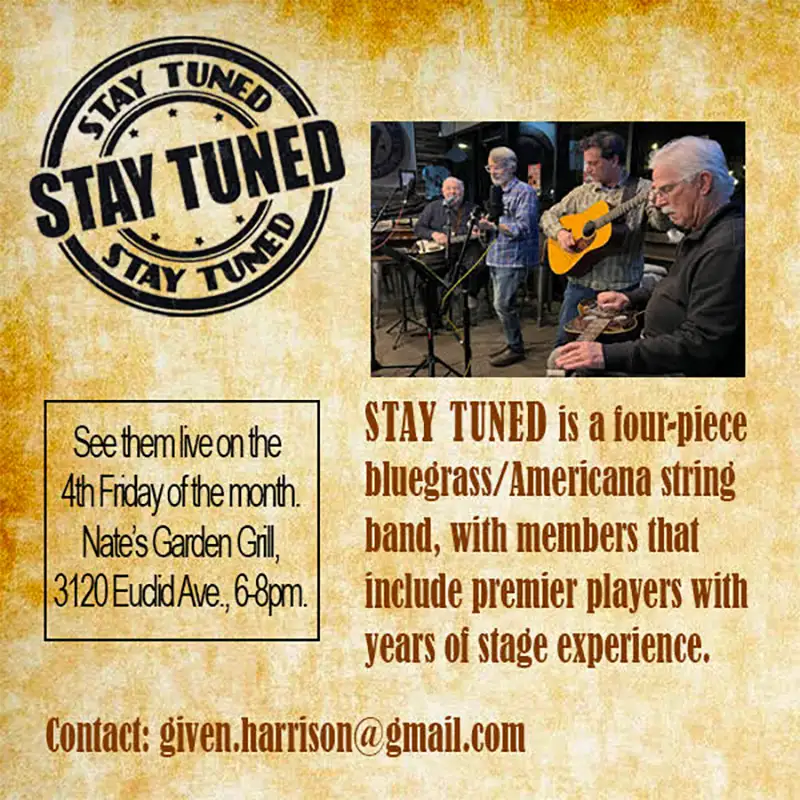CD Reviews
WATSON, BELDOCK & BEACH: Wherever We Roam

Dave Blackburn recorded and mixed Wherever We Roam at Beat ‘n’ Track Recording in Fallbrook; he also plays guitars, drums, and percussion on the album. David Beldock sings lead and backing vocals and plays guitars and keys; Peggy Watson also sings lead and backing vocals and plays guitar; Paul Beach plays bass and sings backing vocals; Tom Keenlyside plays woodwinds and brass on “I Can Fly”; and Robin Adler sings harmony on “Beautiful Song.” All 12 songs were written by Watson and Beldock and the album clocks in at just over 39 minutes.
Wherever We Roam is true folk. It’s comfortable. I can hear the songs being sung around a bonfire. And I could also hear them being sung on stage in a musical; there’s a theatrical feel to their music at times, like there’s more of a story behind the songs. David Beldock has an easy way of singing; he is gentle yet firmly full of expression. Peggy Watson’s voice is touching and clear as a bell, she sings with sincerity and conviction. Together, they harmonize perfectly and have chosen keys that work equally well for each of them so that we hear both of them shine.
The opening song, “Lucky,” begins with Beldock and Watson picking on acoustic guitars. Beldock sings the first verse, Watson sings the second, and then they sweetly harmonize together for the chorus, Oh, darling, oh, darling, I love you more each day. Now we clearly hear Beach on bass—no frills, just a solid thumping in perfect time. At 1:35 Beldock plays a simple, rambling fill before the bridge. The voices join together in a lush harmony line, You just wait and see. Watson sings the last verse, and we hear the chorus twice; Beldock closes with his opening line, I live in a nice little town.
“Wishing Well” has a steadiness about it as Blackburn plays patterns in higher notes that dance along throughout the song, a delightful inertia. That feeling is counter to the lyrics, which find the character a little down and indecisive about his next move in life. Don’t know if I’m gonna stay, threw a coin in anyway. I didn’t see nobody. Far as I can tell, there’s only me and the wishing well. Beldock sings harmony to himself and the effect is as rich and full as a pipe organ. At 1:19 Beldock and Blackburn share an especially sweet guitar solo. Beldock plays lower notes that push and pull your ear to that next line, accented by Blackburn’s higher ones. It’s light and airy and hopeful. Yet, in the end, the character is still unsure, You can never tell, throw a coin in the wishing well.
“To Be You” opens with guitars and keys in foreboding tones along with percussion, but the arrangement leaves open space between the instruments, room to think about what’s being said. This song does some earnest soul-searching resulting in an awareness of the sometimes one-sidedness of racism. Beldock half sings, half speaks, I’ve been thinking of his dream and the truth and what’s right, and everyone knows that it’s well past the time to begin. Beach slides in on bass at :38, and the keys become more insistent; they carry the momentum forward to the heart of the matter: I don’t know what it’s like to be you. Tense guitar accent lines take up the space between the first and second verse. Watson joins in harmony, Even with eyes open wide, I was willfully blind, ‘cause it happened to you, didn’t happen to me. Beldock’s guitar solo begins at 1:50, at first it’s heavy but as it moves along, the feeling lightens as if to bring into focus the need for societal change, Reach in our minds, see the dream not to hate anymore. This is Beldock’s and Watson’s dream.
Feeling like a song by Peter, Paul and Mary, “I Like Science” is a perky, tongue-in-cheek look at the sometimes-twisted view of science seen in the court of public opinion. From the beginning, the bass and guitar somersault along in a rolling intro that begs you to follow as Blackburn handles the percussion softly, filling in the gaps and supporting the lyrics in presenting the case point by point. Watson sings, Don’t let science be sabotaged and shattered by conspiracy theories as mad as the hatter. They twist and turn your mind in strange directions especially during elections. With each chorus the rhythm changes and is filled with strumming guitar and a more sparse and crisp-sounding percussion.
Beldock adds harmony to the bridge at 1:51. Opinions are fine and often very logical, but out there on the internet where science goes to die, an anecdotal thread wraps around your head, and the man behind the curtain is certain to tell you science is a lie. During the second and final choruses Beldock interjects spoken and sung bits of levity: an “mm hmm” or spontaneous mouth trumpet accent here and there cement the definite folk sound. Watson sings her last line, Oh my god, if they stop teaching it, we’re screwed…science.
In my favorite signature of 3/4 time, “Here’s to the Ones We Love” opens with the typical downbeat of the bass, then the strum-strum of the guitar, nice and gentle. I’ve always found that waltzes encourage an audience to join together and sway with the music, and what more would you want to do when listening to this song that raises a glass to all “the ones we love.” Beldock sings the first verse, Here’s to the ones we love, may all their dreams come true. The melody flows easily; it feels almost familiar, but I think it’s just one more aspect of the song that celebrates togetherness. Watson sings the second verse, Here’s to the ones we love, may they be safe and sound. It’s all down-to-earth hope and joy and support for our loved ones. Watson, Beldock, and Beach sing a call to action in flawless three-part harmony in the chorus, “Let your light shine.” After a third verse with Beldock and Watson singing together, we’re back at the chorus and that beautiful harmony with all three repeating “Let your light shine” over and over, I join in myself.
Other tracks are “Let This Be”; “Don’t Know What to Do”; “Beautiful Song”; “Burro”; “I Can Fly,” which breaks the album’s mold a bit and is more jazz-based; and the instrumental “Snow Day.” The last song on the album, “Walk with the Wind,” was inspired by the writings of Congressman John Lewis. It’s worth noting that Watson approached Matt Falker with this song and he arranged and directed a moving choral version of it that can be seen on YouTube at https://www.youtube.com/watch?v=95yjTxKuAWo. The album is streaming everywhere…we roam.








